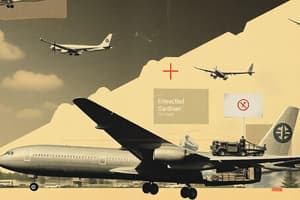Podcast
Questions and Answers
What is the primary purpose of conducting a characteristics analysis?
What is the primary purpose of conducting a characteristics analysis?
- To predict the likelihood of accidents
- To identify the root cause of accidents
- To illustrate the nature of accidents and casualties (correct)
- To develop safety protocols for emergency response
What type of data is typically used in a characteristics analysis of accidents and casualties?
What type of data is typically used in a characteristics analysis of accidents and casualties?
- Descriptive data from news articles
- Qualitative data from witness statements
- Experimental data from simulations
- Quantitative data from incident reports (correct)
What is a key benefit of conducting a characteristics analysis?
What is a key benefit of conducting a characteristics analysis?
- Increasing the accuracy of accident predictions
- Reducing the complexity of accident investigations
- Identifying a single cause of accidents
- Developing targeted safety interventions (correct)
What is the outcome of a characteristics analysis?
What is the outcome of a characteristics analysis?
Why is a characteristics analysis important in accident prevention?
Why is a characteristics analysis important in accident prevention?
What is a common cause of fishing vessel accidents?
What is a common cause of fishing vessel accidents?
Who are the majority of victims of drowning on the Volta Lake?
Who are the majority of victims of drowning on the Volta Lake?
What is a challenge in rescue and emergency response?
What is a challenge in rescue and emergency response?
What environmental factor can contribute to fishing vessel accidents?
What environmental factor can contribute to fishing vessel accidents?
What is a consequence of passenger ferry collisions?
What is a consequence of passenger ferry collisions?
What can contribute to drowning on the Volta Lake?
What can contribute to drowning on the Volta Lake?
What is an initiative to improve rescue and emergency response?
What is an initiative to improve rescue and emergency response?
What is a type of accident that can occur on fishing vessels?
What is a type of accident that can occur on fishing vessels?
What can contribute to passenger ferry accidents?
What can contribute to passenger ferry accidents?
What is a consequence of fishing vessel accidents?
What is a consequence of fishing vessel accidents?
Study Notes
Characteristics Analysis
- The primary purpose of conducting a characteristics analysis is to identify patterns, trends, and relationships between various factors and accidents/casualties.
Data Used
- Typically, a characteristics analysis of accidents and casualties uses descriptive data, such as demographic information (e.g., age, sex, occupation), incident details (e.g., location, time, severity), and environmental factors (e.g., weather, road conditions).
Benefits
- A key benefit of conducting a characteristics analysis is that it helps to inform and prioritize safety interventions, enabling targeted and effective prevention strategies.
Outcome
- The outcome of a characteristics analysis is a comprehensive understanding of the underlying factors contributing to accidents and casualties, which can be used to develop evidence-based prevention measures.
Importance
- A characteristics analysis is important in accident prevention because it enables the identification of high-risk groups and areas, allowing for proactive measures to be taken to reduce the likelihood and impact of accidents.
Fishing Vessel Accidents
- Overloading of vessels, poor vessel maintenance, inadequate safety equipment, and insufficient training of fishermen are common causes of accidents
- Accidents can result in capsizing, collision with other vessels, fire outbreaks, and engine failure
- Consequences of accidents include loss of lives, injury to fishermen, damage to vessels and equipment, and economic losses to fishermen and their families
Drowning Statistics
- The Volta Lake has a high incidence of drowning
- Fishermen and passengers of passenger ferries are the majority of drowning victims
- Contributing factors to drowning include lack of life jackets and other safety equipment, inability to swim, intoxication, and overcrowding of vessels
- There is an average annual drowning rate on the Volta Lake, with a breakdown of drowning cases by age, gender, and occupation
Rescue And Emergency Response
- Limited availability of rescue equipment and personnel, inadequate communication networks, and long response times are challenges to rescue and emergency response
- Initiatives to improve response include establishment of emergency response centers, training of fishermen and emergency responders, and acquisition of rescue equipment and vessels
- Local communities play a crucial role in providing first aid and basic life support, and assisting in search and rescue operations
Environmental Factors Contributing To Accidents
- Strong winds and storms, heavy rainfall and flooding, and fog and reduced visibility are weather conditions that contribute to accidents
- Water conditions that contribute to accidents include strong currents and turbulence, water hyacinth and other aquatic weeds, and low water levels
- Poor lighting and navigation, and the presence of watercraft and other obstacles, are other environmental factors that contribute to accidents
Passenger Ferry Collisions
- Common causes of passenger ferry collisions include excessive speed, poor visibility, inadequate lookout, and insufficient communication
- Consequences of collisions include loss of lives, injury to passengers, damage to vessels and property, and disruption of transportation services
- Safety measures to prevent collisions include enforcing speed limits, installing navigation aids, regular maintenance and inspection of vessels, and conducting passenger safety briefings and drills
Studying That Suits You
Use AI to generate personalized quizzes and flashcards to suit your learning preferences.
Description
This quiz assesses understanding of the characteristics analysis process, its primary purpose, and its application in accident prevention. It covers the type of data used, benefits, and outcomes of conducting a characteristics analysis.




